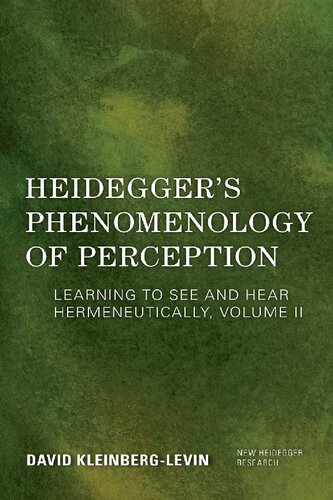

Most ebook files are in PDF format, so you can easily read them using various software such as Foxit Reader or directly on the Google Chrome browser.
Some ebook files are released by publishers in other formats such as .awz, .mobi, .epub, .fb2, etc. You may need to install specific software to read these formats on mobile/PC, such as Calibre.
Please read the tutorial at this link: https://ebookbell.com/faq
We offer FREE conversion to the popular formats you request; however, this may take some time. Therefore, right after payment, please email us, and we will try to provide the service as quickly as possible.
For some exceptional file formats or broken links (if any), please refrain from opening any disputes. Instead, email us first, and we will try to assist within a maximum of 6 hours.
EbookBell Team

4.4
32 reviewsIn volume I, Kleinberg-Levin interprets five key words in Heidegger’s project. In this second volume, he illuminates their significance for Heidegger’s phenomenology of perception and his philosophy of history. At stake is the possibility of a new experience and understanding of being. Taking us beyond the metaphysical understanding of being, Heidegger proposes to introduce a new key word Seyn (beyng). Beyng is the Da-sein-appropriating event in which a clearing occurs as an open dimension for the time-space interplay of concealment and unconcealment, an interplay within which beings are experienced in regard to the various modes and inflections of presence and absence that the grammar of temporalities articulates. Concentrating on the appropriation of seeing and hearing as capacities and capabilities bearing promising potentialities that could be developed, Kleinberg-Levin examines seeing and hearing in the context of Heidegger’s critique of the history of metaphysics, wherein vision has served as paradigm for knowledge, truth, and reality. He shows that, in Heidegger’s philosophy of history, seeing and hearing are given a role in the transformation of the character of humanity, redeeming their own inherent potential. Perceptual experience has undergone accelerating processes of deformation and reification, encouraging a disposition that makes it serve technological and technocratic imperatives; but we might begin to redeem the promising potential in seeing and hearing, turning their damaged and dehumanized character, and their violence, towards the creation of a new planetary existence—what Heidegger imagines through the topology of the fourfold: earth and sky, mortals and the gods who embody our ideals. In this project, we are put in question by a responsibility that summons us, in our seeing and hearing, to the response-abilities most befitting our historically shared sense of an achieved humanity.